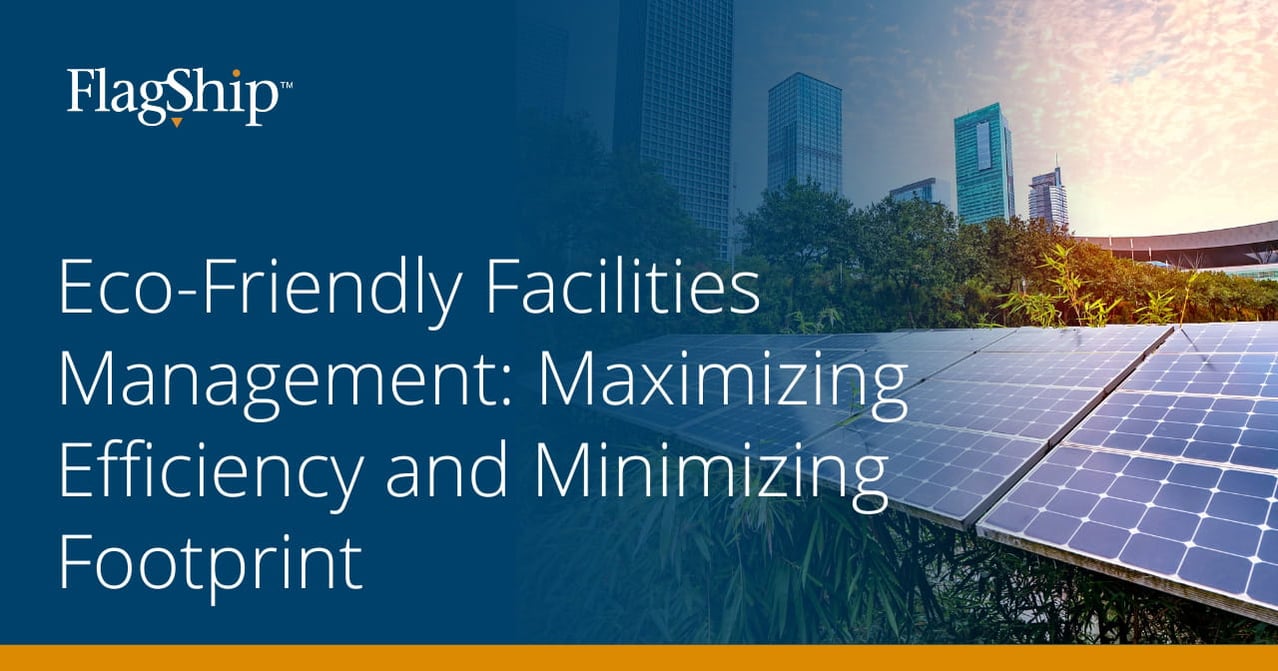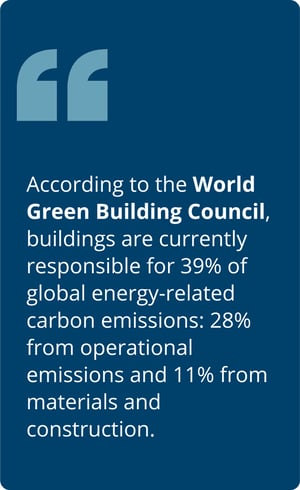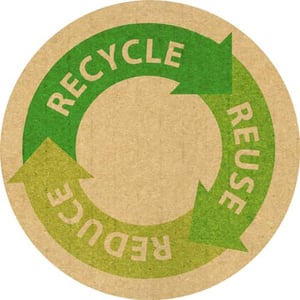
In recent years, the global consciousness surrounding sustainability has grown exponentially. Industries of all types are recognizing the need to minimize their ecological footprint, and facilities management is no exception. Facilities management is responsible for maintaining built environments, covering everything from physical structures and grounds keeping to operational systems and equipment.
Earth Month serves as a call to action for facility managers to assess their carbon footprint and identify areas for improvement. In this blog, we unravel the intricacies of sustainable facilities management, exploring its importance, implications, and the pivotal role it plays in fostering a greener, more resilient future.
Environmental Impact of Facilities Management
As the link between human activity and built environments, facilities management has a significant ecological impact. Understanding the environmental ramifications is critical for developing strategies that promote sustainability and mitigate the adverse effects.
Facilities management encompasses a broad spectrum of functions, and each leaves a mark. These are the aspects responsible for the most pollution and emissions:
 Energy Consumption: The operation of heating, ventilation, and air conditioning (HVAC) systems, along with lighting fixtures, comprises a substantial portion of energy consumption. The inefficient usage of these energy resources leads to higher operational costs and increased carbon emissions, contributing to air pollution and climate change.
Energy Consumption: The operation of heating, ventilation, and air conditioning (HVAC) systems, along with lighting fixtures, comprises a substantial portion of energy consumption. The inefficient usage of these energy resources leads to higher operational costs and increased carbon emissions, contributing to air pollution and climate change.
Water Usage: Plumbing systems and irrigation practices are the leading factors of water consumption within facilities. Irresponsible water management can strain local resources, prompting concerns over water scarcity and ecosystem degradation.
Materials and Construction: The manufacturing process of frequently used construction materials emits harmful gases, which significantly threaten the integrity of the ozone layer. Aluminum, copper, steel, and cement are among the top contributors. The Royal Danish Academy assembled the Construction Material Pyramid, ranking the most environmentally harmful materials to the least.
Waste: Poor waste management and disposal lead to an abundance of air and land pollution, potentially contaminating the surrounding soil and water and creating devastating health and ecological hazards.
Neglecting routine maintenance causes equipment to operate inefficiently, leading to increased energy consumption, water leaks, and structural failures. These consequences heighten carbon emissions and environmental degradation and endanger employee safety.
Sustainability in Action
Integrating sustainable solutions is imperative to effectively combat facilities management's negative environmental impact. The first step in achieving sustainability is conducting a comprehensive audit of current practices. This audit enables facility managers to identify areas for improvement and establish ecologically sound, less impactful alternatives.
While transitioning to an eco-friendlier approach might seem like a major undertaking, there are practical ways to support conservation efforts:
Energy-Efficient Practices
- Lighting Systems Upgrades: Transitioning to energy-efficient lighting technologies, such as LED fixtures, significantly reduces energy consumption and lowers operational costs.
- Preventive/Routine HVAC Maintenance: Implementing preventive maintenance programs for HVAC systems ensures optimal performance, enhances energy efficiency, and prolongs equipment lifespan.
- Smart Buildings for Energy Conservation: Leveraging smart building technologies, including automated controls and sensors, optimizes energy usage by adjusting lighting, temperature, and ventilation based on occupancy and ambient conditions.
Water Conservation
- Low-Flow Fixtures: Installing low-flow faucets, toilets, and showerheads reduces water usage without compromising performance, conserving precious freshwater resources.
- Leak Detection Programs: Implementing proactive leak detection programs enables early identification and repair of water leaks, minimizing water wastage and preventing property damage.
- Sustainable Irrigation Systems: Utilizing efficient irrigation technologies, such as drip irrigation and soil moisture sensors, minimizes water consumption in landscaping and outdoor spaces.
Waste Reduction

- Preventive Maintenance: Regular equipment and infrastructure maintenance prevents breakdowns and extends their lifespan, reducing the need for premature replacements and minimizing waste generation.
- Equipment Updates: Retrofitting or replacing outdated equipment with energy-efficient alternatives improves operational efficiency, reduces energy consumption, and minimizes environmental impact.
- Waste Disposal: Responsible disposal ensures legal compliance and prevents potential ecological contamination. Try classifying waste into categories such as recyclable, hazardous, organic, and non-recycling, and adhere to the proper storage, handling, and disposal regulations set by governmental agencies.
- Use of EPA-Certified and Sustainable Products: Choosing environmentally friendly cleaning products and sustainable materials minimizes chemical exposure, reduces indoor air pollution, and promotes a healthier indoor environment.
- Recycling Initiatives: Enforce the 3Rs – Reduce, Reuse, Recycle. Organizations can reduce waste generation and divert waste from landfills by minimizing packaging, implementing reusable materials, and developing and promoting company-wide recycling programs.
Employing sustainable solutions is a crucial step toward addressing climate change while ensuring continued economic growth. Organizations can honor their commitment to sustainability by partnering with vendors and suppliers who share the same values, guaranteeing eco-friendly practices throughout the supply chain. Additionally, by prioritizing the maintenance and upkeep of facilities, companies can create safer working environments, reducing the risk of accidents and injuries.
Advantages of Sustainable Facilities Maintenance
By integrating eco-conscious facilities management into your operations, organizations can unlock a myriad of benefits, including employee engagement, cost savings, enhanced brand reputation, and long-term profitability and resilience. With energy-efficient resources, water conservation methods, and ecologically sound waste management programs, organizations can not only lower operational expenses over time but also ensure financial endurance by future-proofing facilities against rising energy prices and regulatory changes.
Beyond economic considerations, adopting sustainable practices strengthens companies' brand reputation and market competitiveness. In an increasingly environmentally conscious marketplace, consumers, investors, and stakeholders prioritize sustainability as a key criterion when making purchasing decisions and evaluating an organization's performance. Moreover, strong sustainability credentials can open doors to new business opportunities, partnerships, and markets, distinguishing themselves from competitors.
 Organizations that demonstrate a commitment to sustainability and environmental responsibility foster positive work cultures, enhancing employee satisfaction and loyalty, ultimately leading to improved retention rates. Employees are more likely to remain with companies that prioritize their well-being and establish a dedication to ethical and sustainable business practices. Environmental conservation also serves as an attractive recruitment tool, appealing to environmentally conscious candidates seeking employment opportunities aligned with their values and beliefs.
Organizations that demonstrate a commitment to sustainability and environmental responsibility foster positive work cultures, enhancing employee satisfaction and loyalty, ultimately leading to improved retention rates. Employees are more likely to remain with companies that prioritize their well-being and establish a dedication to ethical and sustainable business practices. Environmental conservation also serves as an attractive recruitment tool, appealing to environmentally conscious candidates seeking employment opportunities aligned with their values and beliefs.
Committing to Sustainability
Sustainable facilities management emerges not only as a logical response to climate change but also as a resourceful strategy for organizations seeking to thrive in a rapidly evolving business landscape. To effectively address the challenges of sustainability, organizations must emphasize the significance of sustainable facilities management and encourage company-wide participation to drive meaningful change and realize the full potential of their sustainability initiatives.
Ultimately, by embracing sustainability as a core value and integrating it into every facet of operations, companies can position themselves as leaders in environmental stewardship, innovation, and social responsibility, minimizing their carbon footprint and paving the way for a more sustainable and prosperous future.
Flagship recognizes the built environments' substantial role in contributing to global carbon emissions, and we strive to help mitigate this impact through sustainable practices and innovative solutions.
Our eco-conscious approach to facilities maintenance has helped clients achieve their sustainability goals, leading to a more environmentally responsible and resilient future.
Here are some Flagship resources to aid in your sustainability journey:
- Paving the Way for Greener Airports
- Flagship Establishes Sustainability Road Map for Automotive Client
- 4 Ways to Promote Sustainable Facilities Management
Talk to a Flagship expert today to explore the sustainable solution we can offer your facility.





Leave a Comment